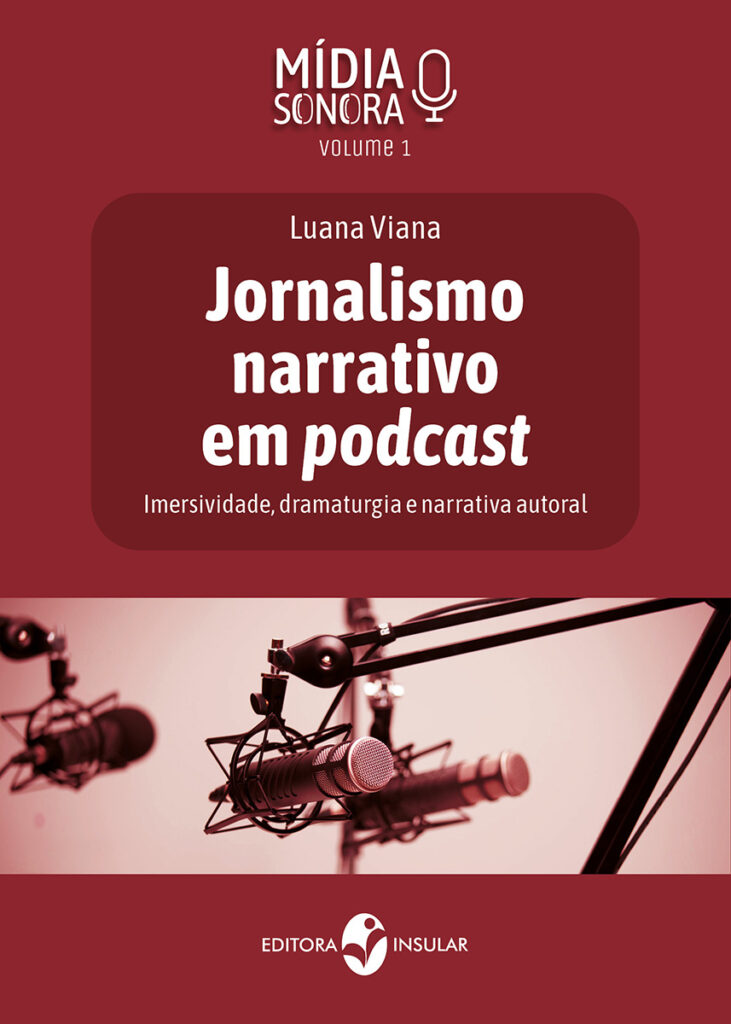Latin America’s podcast market is expected to be the fastest growing in the world by 2032, according to market research published in September, and journalism podcasts in particular occupy an important space in this market.
Some of the most innovative are narrative journalism podcasts, like Radio Ambulante or those in the true crime genre. These podcasts employ creative narrative techniques to involve audiences in the story, such as by using plot twists or direct dialog with listeners.

Professor and book auhtor Luana Viana, from the Federal University of Ouro Preto (Photo: Courtesy
It is precisely these narrative strategies that Luana Viana, a professor in the post-graduate program in Social Communication at the Federal University of Ouro Preto, in Brazil, analyzes in her new book "Narrative journalism in podcasts: Immersiveness, drama and author-led narrative," published at the beginning of June. Adapted from her doctoral thesis completed last year at the Federal University of Juiz de Fora, the research, which is pioneering in Brazil, scrutinizes different ways in which narrative journalism in podcasts seeks to involve its audience, from sound effects to scene description.
The concept of immersion is central to Viana’s work. In an interview with LatAm Journalism Review (LJR), she defined it this way: "There is immersion when there is an erasure of the mediating medium. When we think of sound immersion, it's like erasing the medium that emits the sounds."
The author said that audio narratives are already, by nature, more immersive than other media. "You close your eyes and listen to an audio, and then you're automatically transported to that audio. We are transported into what is being told in the audio, into the narrative," she told LJR.
Two factors determine this immersion, according to Viana. First, there are technological criteria, such as the use of headphones, which create "a greater sense of intimacy, with the narrator speaking into your ear."
Second, there are narrative aspects, precisely the element on which her research focuses, which has earned her awards from the Brazilian Society for Interdisciplinary Communication Studies and the Brazilian Association of Journalism Researchers.
Based on our interview with Viana, LJR presents seven strategies for narrative journalism in podcasts to create an immersive experience for listeners:
The use of complex characters with a life of their own, rather than as mere sources of information, is the first element highlighted by Viana.
"Sources in traditional journalism will often be treated as characters in this case, with well-defined roles in the narrative," Viana said. "The idea is to bring the character closer to the listener, so that they understand that the character is an ordinary person."
To do this, for example, you could talk about the character's daily life, or about their inner life.
"What habits do the characters have? What are their feelings?" she said.
The goal is to humanize the source. Among examples of those who use this approach a lot, Viana said, are Radio Ambulante, which tells the stories of Latino immigrants in the United States, and the program Rádio Novelo Apresenta, which tells stories experienced by ordinary people in Brazil.
"The source is not there simply to give a statement, but is a person who has feelings, and these feelings reverberate in the story that is being told," she said.2) First-person use
Humanization doesn't just concern the characters, but also the narrators, in what Viana describes as one of the "most interesting" practices of narrative journalism in podcasts.
"By using the first person, the journalist also gets closer to the listener," Viana said. "By presenting his feelings and doubts, a journalist is no longer the sterile figure we always see working in traditional journalism. They are also present in the narrative as a person, just like the listener."
Viana noted how - in a technique often used, for example, by Rádio Escafandro - the person who works on the story makes clear their problems with the story, their expectations, mixed-feelings and frustrations.
According to Viana, this goes against the expectation that journalism should be impartial and neutral.
"In fact, we can't put our values aside when we're doing journalism. So this first-person journalist shows how the journalist is also a person, a human being, and that you can't set aside these values," she said.
Even so, Viana noted, this does not diminish the journalistic value of the productions.
"At the same time, the journalism produced is not contaminated by the journalist's impressions, because the journalist still uses basic principles, such as the need to listen to a wide range of people, and also to investigate thoroughly."
Another strategy identified by Viana is transparency with the listener, through explanations of why decisions were made and what the choices were. The author defines this as "metajournalism."
"When you make your choices transparent to the audience, the audience can understand what options were available and what choices the journalist made," Viana said. "For example, they can know why they heard one character at one point and not another, or why they read one document instead of another."
According to Viana, this can create a balance to compensate for the marked presence of the narrator during the story. An example of this quoted by Viana is in the podcast "The Evandro Case," which the book discusses in detail.
"At one point, there's a suicide note, and the narrator chooses not to read it. He makes this decision clear, he says 'look, there's a suicide letter, but out of respect for the family, I won't read it, because it won't add anything to our narrative,'" Viana said.
The absence of images in podcasts, in contrast to visual media, can serve to spark the listener's imagination, allowing each person to create a personal scene in their head, Viana said.
"The advantage of podcasts is that when we imagine through descriptions, we do it in a way that is very particular to us, very personal. So it ends up being a more personalized narrative than the one offered by a visual medium, which arrives ready-made."
Similarly, there are sentences addressed directly to the audience, for example through rhetorical questions, or by stimulating reflection.
"When a narrator addresses a sentence to the listeners, he or she takes into account and values the presence of the audience, speaking directly to them. The listener then also feels included, part of the story," Viana said. "For example, when the narrator says 'you, who are listening to me, what do you think about this?’
According to Viana, every time a narrator stirs a listener's imagination, they also manage to capture the person's attention and make them pay attention to the story being told.
"As a result, someone is transported into the story, gets caught up in it, and is interested in continuing to listen."

Cover of "Narrative journalism in podcasts: Immersiveness, drama and author-led narrative", by Editora Insular
Drama that drives narrative doesn’t usually follow a linear order, but is often interspersed with twists and turns and suspension points - cliffhangers and plot-twists - according to the terminology used by Viana.
"A plot-twist is a turning point, where we've been following a sequence and narrative and suddenly something happens that changes the whole course of the story. The cliffhanger is that moment on the edge of the abyss at the end of an episode, where you think there's nowhere left for the character to run. And, then, there's a turning point in the next episode."
According to Viana, these strategies are especially important in long narratives, in order to hold the listener's attention.
"This isn't new, there was already a lot of it in movies, radio soap operas and other forms of narrative journalism," Viana said. "The idea is precisely to pique the listener's curiosity, making them return to listen to subsequent episodes. It's very common, and it happens all the time."
There are also often stories in which old scenes are interspersed with others from the present, where the narrative doesn’t follow a straight line.
It's common for narrators to present the facts at the pace of their discoveries, as if the listeners were following the investigation, Viana said.
"The story then appears as a construction. It's not ready yet, we follow the narrator back and forth in time, as he or she discovers something different, or some important clue," Viana said.
In exhaustive investigations, this is important for the listener to be able to follow the plot, she said.
"In this back and forth in time, when you discover something different or an important clue, it allows the listener to remember issues that were left behind. It allows them to follow the events again."
All these elements are based on one of the main advantages of the podcast format: the extended play made possible by the limitless nature of the internet.
"On traditional radio, there's a very limited programming schedule, there's a predetermined amount of time. In podcasts, this timeframe is much more flexible," Viana said. "So a narrator sometimes plans a 30-minute episode, but that episode ends up being three hours long, precisely because there is time and space to tell a story in depth."
This depth is also a hallmark of narrative podcasts compared to more common journalism formats, Viana said.
"It's feasible to go as deep as possible into each piece of information that is given. This is also a great differentiator of this narrative format."